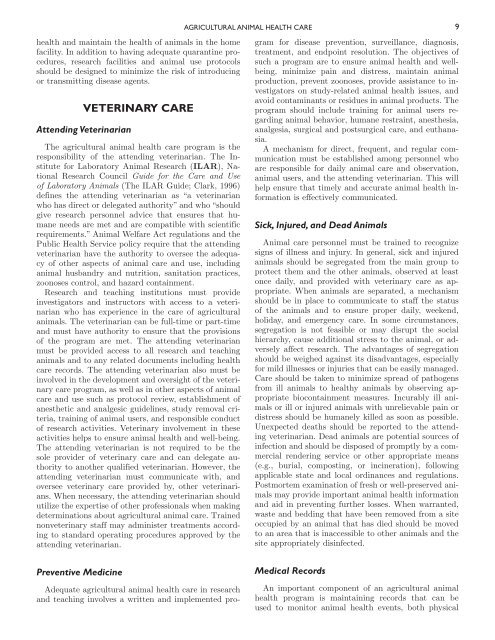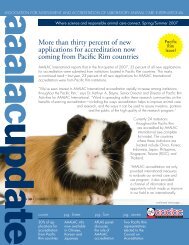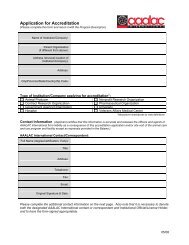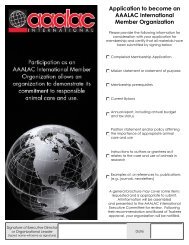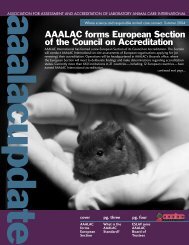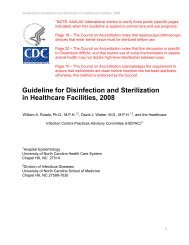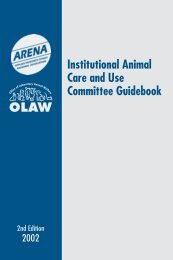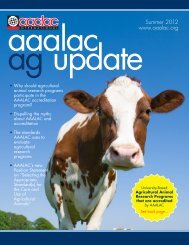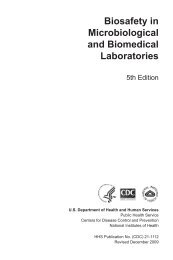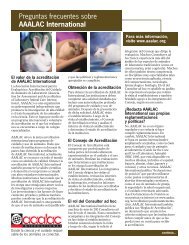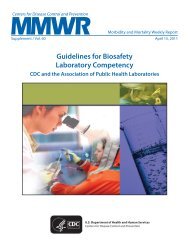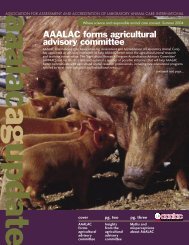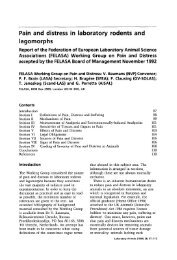Chapter 2: <strong>Agricultural</strong> Animal Health <strong>Care</strong><strong>Agricultural</strong> animal health care <strong>in</strong>volves propermanagement <strong>and</strong> husb<strong>and</strong>ry as well as veter<strong>in</strong>arycare. Proper management is essential <strong>for</strong><strong>the</strong> well-be<strong>in</strong>g <strong>of</strong> animals, <strong>the</strong> validity <strong>and</strong> effectiveness<strong>of</strong> research <strong>and</strong> teach<strong>in</strong>g activities, <strong>and</strong> <strong>the</strong> health<strong>and</strong> safety <strong>of</strong> animal care personnel. Sound animal husb<strong>and</strong>ryprograms provide systems <strong>of</strong> care that permit<strong>the</strong> animals to grow, mature, reproduce, express somespecies-specific behavior, <strong>and</strong> be healthy. Specific operat<strong>in</strong>gprocedures depend on factors that are uniqueto <strong>in</strong>dividual <strong>in</strong>stitutions. Well-tra<strong>in</strong>ed <strong>and</strong> motivatedpersonnel can <strong>of</strong>ten achieve high-quality animal carewith less than ideal physical plants <strong>and</strong> equipment.ANIMAL PROCUREMENTWhen an <strong>in</strong>stitution acquires new animals, attentionmust be paid to applicable <strong>in</strong>ternational, federal,<strong>and</strong> state regulations <strong>and</strong> <strong>in</strong>stitutional procedures, particularlythose deal<strong>in</strong>g with transportation <strong>and</strong> animalhealth. All animals must be obta<strong>in</strong>ed <strong>and</strong> transportedlegally. The attend<strong>in</strong>g veter<strong>in</strong>arian, <strong>in</strong> conjunction with<strong>the</strong> pr<strong>in</strong>cipal scientist, should <strong>for</strong>mulate written proceduresto assess <strong>the</strong> health status <strong>of</strong> a herd or flockobta<strong>in</strong>ed from a vendor be<strong>for</strong>e acquir<strong>in</strong>g animals. The<strong>in</strong>stitution should develop a mechanism <strong>and</strong> process <strong>of</strong>control <strong>for</strong> animal acquisition that ensures coord<strong>in</strong>ation<strong>of</strong> resources that will preclude <strong>the</strong> arrival <strong>of</strong> animals <strong>in</strong>advance <strong>of</strong> preparation <strong>of</strong> adequate hous<strong>in</strong>g <strong>and</strong> appropriateveter<strong>in</strong>ary quarant<strong>in</strong>e procedures. Qualitycontrol <strong>for</strong> vendors <strong>and</strong> knowledge <strong>of</strong> <strong>the</strong> history <strong>of</strong>purchased animals is part <strong>of</strong> an adequate <strong>in</strong>stitutionalveter<strong>in</strong>ary care program. <strong>Animals</strong> <strong>of</strong> unknown orig<strong>in</strong>or from stockyards should only be used if necessary;such animals may pose significant unknown health riskscompared with animals <strong>of</strong> known orig<strong>in</strong> <strong>and</strong> <strong>the</strong>re<strong>for</strong>eshould be h<strong>and</strong>led appropriately. Newly acquired animalsshould undergo a quarant<strong>in</strong>e <strong>and</strong> acclimation period,<strong>in</strong>clud<strong>in</strong>g preventive <strong>and</strong> cl<strong>in</strong>ical treatments asappropriate <strong>for</strong> <strong>the</strong>ir health status.Acclimation <strong>and</strong> StabilizationNewly arrived animals require a period <strong>of</strong> acclimation.Acclimation refers to a stabilization period, be<strong>for</strong>e8animal use, which permits physiological <strong>and</strong> behavioraladaptation to <strong>the</strong> new environment. The attend<strong>in</strong>g veter<strong>in</strong>arianshould establish general acclimation guidel<strong>in</strong>es<strong>for</strong> each species. Any modifications to <strong>the</strong> generalprogram should be discussed with <strong>the</strong> attend<strong>in</strong>g veter<strong>in</strong>arianbe<strong>for</strong>e animals are shipped. In some cases,animals may require an extended acclimation periodbecause <strong>of</strong> <strong>the</strong>ir history or health status. On <strong>the</strong> o<strong>the</strong>rh<strong>and</strong>, some studies, such as comparisons <strong>of</strong> metaphylactictreatments <strong>for</strong> shipp<strong>in</strong>g fever, need to beg<strong>in</strong> assoon as animals arrive. Such exemptions from <strong>the</strong> acclimationperiod must be scientifically justified <strong>and</strong> approvedby <strong>the</strong> Institutional Animal <strong>Care</strong> <strong>and</strong> <strong>Use</strong> Committee(IACUC).Quarant<strong>in</strong>eQuarant<strong>in</strong>e is <strong>the</strong> separation <strong>of</strong> newly receivedanimals from those already <strong>in</strong> <strong>the</strong> facility or on <strong>the</strong>premises until <strong>the</strong> health <strong>of</strong> <strong>the</strong> new animals has beenevaluated <strong>and</strong> found to be acceptable. The attend<strong>in</strong>gveter<strong>in</strong>arian should ensure that quarant<strong>in</strong>e facilities orlocations are appropriate <strong>and</strong> that quarant<strong>in</strong>e proceduresare consistent with current veter<strong>in</strong>ary practices<strong>and</strong> applicable regulations. The quarant<strong>in</strong>e periodshould be long enough to observe signs <strong>of</strong> <strong>in</strong>fectiousdisease or obta<strong>in</strong> diagnostic evidence <strong>of</strong> <strong>in</strong>fection status.Quarant<strong>in</strong>e <strong>and</strong> test<strong>in</strong>g <strong>of</strong> animals be<strong>for</strong>e <strong>in</strong>troductionis especially important <strong>for</strong> herds or flocks thathave atta<strong>in</strong>ed specific-pathogen-free status, but <strong>the</strong>seadditions should be discouraged. If <strong>the</strong> health history<strong>of</strong> newly received animals is unknown, <strong>the</strong> quarant<strong>in</strong>eprogram should be more comprehensive <strong>and</strong> sufficientlylong to allow expression or detection <strong>of</strong> diseases present<strong>in</strong> <strong>the</strong> early <strong>in</strong>cubation stage. Exceptions to quarant<strong>in</strong>epractices should be approved by <strong>the</strong> attend<strong>in</strong>g veter<strong>in</strong>arian<strong>in</strong> advance <strong>of</strong> shipment <strong>of</strong> <strong>the</strong> animals.The attend<strong>in</strong>g veter<strong>in</strong>arian, or skilled personnel under<strong>the</strong> direction <strong>of</strong> <strong>the</strong> attend<strong>in</strong>g veter<strong>in</strong>arian, shouldper<strong>for</strong>m an <strong>in</strong>itial exam<strong>in</strong>ation <strong>and</strong> subsequent dailyobservations <strong>for</strong> newly arrived animals. <strong>Animals</strong> shouldbe observed <strong>in</strong> quarant<strong>in</strong>e until <strong>the</strong>y are cleared <strong>for</strong> <strong>in</strong>troduction<strong>in</strong>to a herd or facility. Dur<strong>in</strong>g <strong>the</strong> quarant<strong>in</strong>eperiod, animals should be vacc<strong>in</strong>ated <strong>and</strong> treated <strong>for</strong>diseases <strong>and</strong> parasites as appropriate to protect <strong>the</strong>ir
health <strong>and</strong> ma<strong>in</strong>ta<strong>in</strong> <strong>the</strong> health <strong>of</strong> animals <strong>in</strong> <strong>the</strong> homefacility. In addition to hav<strong>in</strong>g adequate quarant<strong>in</strong>e procedures,research facilities <strong>and</strong> animal use protocolsshould be designed to m<strong>in</strong>imize <strong>the</strong> risk <strong>of</strong> <strong>in</strong>troduc<strong>in</strong>gor transmitt<strong>in</strong>g disease agents.VETERINARY CAREAttend<strong>in</strong>g Veter<strong>in</strong>arianThe agricultural animal health care program is <strong>the</strong>responsibility <strong>of</strong> <strong>the</strong> attend<strong>in</strong>g veter<strong>in</strong>arian. The Institute<strong>for</strong> Laboratory Animal <strong>Research</strong> (ILAR), National<strong>Research</strong> Council <strong>Guide</strong> <strong>for</strong> <strong>the</strong> <strong>Care</strong> <strong>and</strong> <strong>Use</strong><strong>of</strong> Laboratory <strong>Animals</strong> (The ILAR <strong>Guide</strong>; Clark, 1996)def<strong>in</strong>es <strong>the</strong> attend<strong>in</strong>g veter<strong>in</strong>arian as “a veter<strong>in</strong>arianwho has direct or delegated authority” <strong>and</strong> who “shouldgive research personnel advice that ensures that humaneneeds are met <strong>and</strong> are compatible with scientificrequirements.” Animal Welfare Act regulations <strong>and</strong> <strong>the</strong>Public Health Service policy require that <strong>the</strong> attend<strong>in</strong>gveter<strong>in</strong>arian have <strong>the</strong> authority to oversee <strong>the</strong> adequacy<strong>of</strong> o<strong>the</strong>r aspects <strong>of</strong> animal care <strong>and</strong> use, <strong>in</strong>clud<strong>in</strong>ganimal husb<strong>and</strong>ry <strong>and</strong> nutrition, sanitation practices,zoonoses control, <strong>and</strong> hazard conta<strong>in</strong>ment.<strong>Research</strong> <strong>and</strong> teach<strong>in</strong>g <strong>in</strong>stitutions must provide<strong>in</strong>vestigators <strong>and</strong> <strong>in</strong>structors with access to a veter<strong>in</strong>arianwho has experience <strong>in</strong> <strong>the</strong> care <strong>of</strong> agriculturalanimals. The veter<strong>in</strong>arian can be full-time or part-time<strong>and</strong> must have authority to ensure that <strong>the</strong> provisions<strong>of</strong> <strong>the</strong> program are met. The attend<strong>in</strong>g veter<strong>in</strong>arianmust be provided access to all research <strong>and</strong> teach<strong>in</strong>ganimals <strong>and</strong> to any related documents <strong>in</strong>clud<strong>in</strong>g healthcare records. The attend<strong>in</strong>g veter<strong>in</strong>arian also must be<strong>in</strong>volved <strong>in</strong> <strong>the</strong> development <strong>and</strong> oversight <strong>of</strong> <strong>the</strong> veter<strong>in</strong>arycare program, as well as <strong>in</strong> o<strong>the</strong>r aspects <strong>of</strong> animalcare <strong>and</strong> use such as protocol review, establishment <strong>of</strong>anes<strong>the</strong>tic <strong>and</strong> analgesic guidel<strong>in</strong>es, study removal criteria,tra<strong>in</strong><strong>in</strong>g <strong>of</strong> animal users, <strong>and</strong> responsible conduct<strong>of</strong> research activities. Veter<strong>in</strong>ary <strong>in</strong>volvement <strong>in</strong> <strong>the</strong>seactivities helps to ensure animal health <strong>and</strong> well-be<strong>in</strong>g.The attend<strong>in</strong>g veter<strong>in</strong>arian is not required to be <strong>the</strong>sole provider <strong>of</strong> veter<strong>in</strong>ary care <strong>and</strong> can delegate authorityto ano<strong>the</strong>r qualified veter<strong>in</strong>arian. However, <strong>the</strong>attend<strong>in</strong>g veter<strong>in</strong>arian must communicate with, <strong>and</strong>oversee veter<strong>in</strong>ary care provided by, o<strong>the</strong>r veter<strong>in</strong>arians.When necessary, <strong>the</strong> attend<strong>in</strong>g veter<strong>in</strong>arian shouldutilize <strong>the</strong> expertise <strong>of</strong> o<strong>the</strong>r pr<strong>of</strong>essionals when mak<strong>in</strong>gdeterm<strong>in</strong>ations about agricultural animal care. Tra<strong>in</strong>ednonveter<strong>in</strong>ary staff may adm<strong>in</strong>ister treatments accord<strong>in</strong>gto st<strong>and</strong>ard operat<strong>in</strong>g procedures approved by <strong>the</strong>attend<strong>in</strong>g veter<strong>in</strong>arian.AGRICULTURAL ANIMAL HEALTH CAREAdequate agricultural animal health care <strong>in</strong> research<strong>and</strong> teach<strong>in</strong>g <strong>in</strong>volves a written <strong>and</strong> implemented program<strong>for</strong> disease prevention, surveillance, diagnosis,treatment, <strong>and</strong> endpo<strong>in</strong>t resolution. The objectives <strong>of</strong>such a program are to ensure animal health <strong>and</strong> wellbe<strong>in</strong>g,m<strong>in</strong>imize pa<strong>in</strong> <strong>and</strong> distress, ma<strong>in</strong>ta<strong>in</strong> animalproduction, prevent zoonoses, provide assistance to <strong>in</strong>vestigatorson study-related animal health issues, <strong>and</strong>avoid contam<strong>in</strong>ants or residues <strong>in</strong> animal products. Theprogram should <strong>in</strong>clude tra<strong>in</strong><strong>in</strong>g <strong>for</strong> animal users regard<strong>in</strong>ganimal behavior, humane restra<strong>in</strong>t, anes<strong>the</strong>sia,analgesia, surgical <strong>and</strong> postsurgical care, <strong>and</strong> euthanasia.A mechanism <strong>for</strong> direct, frequent, <strong>and</strong> regular communicationmust be established among personnel whoare responsible <strong>for</strong> daily animal care <strong>and</strong> observation,animal users, <strong>and</strong> <strong>the</strong> attend<strong>in</strong>g veter<strong>in</strong>arian. This willhelp ensure that timely <strong>and</strong> accurate animal health <strong>in</strong><strong>for</strong>mationis effectively communicated.Sick, Injured, <strong>and</strong> Dead <strong>Animals</strong>Animal care personnel must be tra<strong>in</strong>ed to recognizesigns <strong>of</strong> illness <strong>and</strong> <strong>in</strong>jury. In general, sick <strong>and</strong> <strong>in</strong>juredanimals should be segregated from <strong>the</strong> ma<strong>in</strong> group toprotect <strong>the</strong>m <strong>and</strong> <strong>the</strong> o<strong>the</strong>r animals, observed at leastonce daily, <strong>and</strong> provided with veter<strong>in</strong>ary care as appropriate.When animals are separated, a mechanismshould be <strong>in</strong> place to communicate to staff <strong>the</strong> status<strong>of</strong> <strong>the</strong> animals <strong>and</strong> to ensure proper daily, weekend,holiday, <strong>and</strong> emergency care. In some circumstances,segregation is not feasible or may disrupt <strong>the</strong> socialhierarchy, cause additional stress to <strong>the</strong> animal, or adverselyaffect research. The advantages <strong>of</strong> segregationshould be weighed aga<strong>in</strong>st its disadvantages, especially<strong>for</strong> mild illnesses or <strong>in</strong>juries that can be easily managed.<strong>Care</strong> should be taken to m<strong>in</strong>imize spread <strong>of</strong> pathogensfrom ill animals to healthy animals by observ<strong>in</strong>g appropriatebioconta<strong>in</strong>ment measures. Incurably ill animalsor ill or <strong>in</strong>jured animals with unrelievable pa<strong>in</strong> ordistress should be humanely killed as soon as possible.Unexpected deaths should be reported to <strong>the</strong> attend<strong>in</strong>gveter<strong>in</strong>arian. Dead animals are potential sources <strong>of</strong><strong>in</strong>fection <strong>and</strong> should be disposed <strong>of</strong> promptly by a commercialrender<strong>in</strong>g service or o<strong>the</strong>r appropriate means(e.g., burial, compost<strong>in</strong>g, or <strong>in</strong>c<strong>in</strong>eration), follow<strong>in</strong>gapplicable state <strong>and</strong> local ord<strong>in</strong>ances <strong>and</strong> regulations.Postmortem exam<strong>in</strong>ation <strong>of</strong> fresh or well-preserved animalsmay provide important animal health <strong>in</strong><strong>for</strong>mation<strong>and</strong> aid <strong>in</strong> prevent<strong>in</strong>g fur<strong>the</strong>r losses. When warranted,waste <strong>and</strong> bedd<strong>in</strong>g that have been removed from a siteoccupied by an animal that has died should be movedto an area that is <strong>in</strong>accessible to o<strong>the</strong>r animals <strong>and</strong> <strong>the</strong>site appropriately dis<strong>in</strong>fected.9Preventive Medic<strong>in</strong>eMedical RecordsAn important component <strong>of</strong> an agricultural animalhealth program is ma<strong>in</strong>ta<strong>in</strong><strong>in</strong>g records that can beused to monitor animal health events, both physical
- Page 1 and 2: Guide for the Care and Useof Agricu
- Page 3 and 4: Guide Revision Committees for the F
- Page 5 and 6: Chapter 6: Beef Cattle 61Facilities
- Page 7: PrefaceThis is the third edition of
- Page 10 and 11: 2 CHAPTER 1The IACUC should meet at
- Page 12 and 13: 4 CHAPTER 1tion Center at the Natio
- Page 14 and 15: 6 CHAPTER 1Disposition of Animal Cl
- Page 18 and 19: 10 CHAPTER 2and behavioral health e
- Page 20 and 21: 12 CHAPTER 2care attendants or rese
- Page 22 and 23: 14 CHAPTER 2exposed to these chemic
- Page 24 and 25: Chapter 3: Husbandry, Housing, and
- Page 26 and 27: 18 CHAPTER 3Most agricultural anima
- Page 28 and 29: 20 CHAPTER 3gases, particulates, an
- Page 30 and 31: 22 CHAPTER 3in pairs or groups when
- Page 32 and 33: 24 CHAPTER 3screened with 1.3-cm (0
- Page 34 and 35: 26 CHAPTER 3priate, and institution
- Page 36 and 37: 28 CHAPTER 3ings and Deliberations.
- Page 38 and 39: Chapter 4: Environmental Enrichment
- Page 40 and 41: 32 CHAPTER 4(Feh and de Mazieres, 1
- Page 42 and 43: 34 CHAPTER 4Substrate: The provisio
- Page 44 and 45: 36 CHAPTER 4mize regrouping and soc
- Page 46 and 47: 38 CHAPTER 4not especially attracte
- Page 48 and 49: 40 CHAPTER 4Croney, C. C., K. M. Ad
- Page 50 and 51: 42 CHAPTER 4Meunier-Salaün, M. C.,
- Page 52 and 53: 44 CHAPTER 4Wilson, S. C., F. M. Mi
- Page 54 and 55: 46 CHAPTER 5dling facility in the f
- Page 56 and 57: 48 CHAPTER 5Table 5-1. Visual distr
- Page 58 and 59: 50 CHAPTER 5Animals should be handl
- Page 60 and 61: 52 CHAPTER 5be given during conditi
- Page 62 and 63: 54 CHAPTER 5mercial broiler farms,
- Page 64 and 65: 56 CHAPTER 5The condition of the an
- Page 66 and 67:
58 CHAPTER 5Arnold, G. W. 1977. An
- Page 68 and 69:
60 CHAPTER 5for veterinary and husb
- Page 70 and 71:
62 CHAPTER 6managers of confined ca
- Page 72 and 73:
64 CHAPTER 6Cold housing can be pro
- Page 74 and 75:
66 CHAPTER 6HUSBANDRYAdequate care
- Page 76 and 77:
68 CHAPTER 6ately to perform a caes
- Page 78 and 79:
70 CHAPTER 6minimum amount of time
- Page 80 and 81:
72 CHAPTER 6Ensminger, M. E. 1970.
- Page 82 and 83:
Chapter 7: Dairy CattleDairy cattle
- Page 84 and 85:
76 CHAPTER 7Table 7-1. Recommended
- Page 86 and 87:
78 CHAPTER 7ties should be provided
- Page 88 and 89:
80 CHAPTER 7quent feeding, and exce
- Page 90 and 91:
82 CHAPTER 7hanced sensitivity to h
- Page 92 and 93:
84 CHAPTER 7effective for removing
- Page 94 and 95:
86 CHAPTER 7Albright, J. L. 1978. S
- Page 96 and 97:
88 CHAPTER 7Murphy, M. R., C. L. Da
- Page 98 and 99:
Chapter 8: HorsesMost horses are us
- Page 100 and 101:
92 CHAPTER 8Temperature and Ventila
- Page 102 and 103:
94 CHAPTER 8tritional programs for
- Page 104 and 105:
96 CHAPTER 8WaterClean water should
- Page 106 and 107:
98 CHAPTER 8bots (Gastrophilus inte
- Page 108 and 109:
100 CHAPTER 8STANDARD AGRICULTURALP
- Page 110 and 111:
102 CHAPTER 8of Animals. C. McGowan
- Page 112 and 113:
104 CHAPTER 9dom of movement, runni
- Page 114 and 115:
106 CHAPTER 92006). Developing bree
- Page 116 and 117:
108 CHAPTER 9Table 9-3. Minimum fee
- Page 118 and 119:
110 CHAPTER 9Table 9-7. Minimum dri
- Page 120 and 121:
112 CHAPTER 9Table 9-10. Minimum fl
- Page 122 and 123:
114 CHAPTER 9Table 9-12. Minimum fl
- Page 124 and 125:
116 CHAPTER 9ery effort should be m
- Page 126 and 127:
118 CHAPTER 9guides, available from
- Page 128 and 129:
120 CHAPTER 9nutritive pecking decr
- Page 130 and 131:
122 CHAPTER 9rapidly fragmented by
- Page 132 and 133:
124 CHAPTER 9Brambell, F. W. R. 196
- Page 134 and 135:
126 CHAPTER 9Hughes, B. O., and M.
- Page 136 and 137:
128 CHAPTER 9chickens grown with tw
- Page 138 and 139:
130 CHAPTER 10Table 10-1. Recommend
- Page 140 and 141:
132 CHAPTER 10prevented or minimize
- Page 142 and 143:
134 CHAPTER 10and well-being (Matte
- Page 144 and 145:
136 CHAPTER 10via colostrum (de la
- Page 146 and 147:
138 CHAPTER 10thoroughly at the beg
- Page 148 and 149:
140 CHAPTER 10Ames, D. R., J. E. Ne
- Page 150 and 151:
142 CHAPTER 102006. Semen and repro
- Page 152 and 153:
144 CHAPTER 11Table 11-1. Recommend
- Page 154 and 155:
146 CHAPTER 11vided in the creep ar
- Page 156 and 157:
148 CHAPTER 11Table 11-2. Minimum f
- Page 158 and 159:
150 CHAPTER 11are kept in small gro
- Page 160 and 161:
152 CHAPTER 11sonable to consolidat
- Page 162 and 163:
154 CHAPTER 11Blackshaw, J. K., F.
- Page 164 and 165:
156 CHAPTER 11populations structure
- Page 166 and 167:
Appendix 2Table A-1. Zoonotic disea
- Page 168 and 169:
IndexAAABP (American Association of
- Page 170 and 171:
162 INDEXcold climates. See also te
- Page 172 and 173:
164 INDEXdairy, 137disbudding of, 1
- Page 174 and 175:
166 INDEXmisters, 19mites, 98Model
- Page 176 and 177:
168 INDEXin horse stalls, 90in poul


